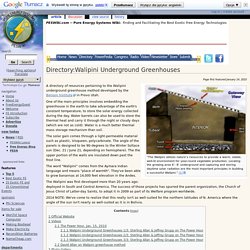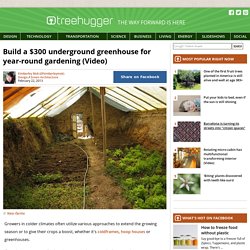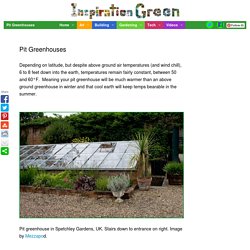

Kimberli Wieghat
How To Reuse Pallets. Walipini Underground Greenhouses. From PESWiki Page first featured January 14, 2010 "The Walipini utilizes nature’s resources to provide a warm, stable, well-lit environment for year-round vegetable production.

Locating the growing area 6’- 8’ underground and capturing and storing daytime solar radiation are the most important principles in building a successful Walipini. " [1] A directory of resources pertaining to the Walipini underground greenhouse mothod developed by the Benson Institute in Provo Utah. One of the main principles involves embedding the greenhouse in the earth to take advantage of the earth's constant temperature, to store the solar energy collected during the day.
The solar gain comes through a light-permeable material such as plastic, Visqueen, polycarbinate. The word "Walipini" comes from the Aymara Indian language and means "place of warmth". The Walipini was first developed more than 20 years ago; deployed in South and Central America. Official Website Videos The Power Hour, Jan. 15, 2010 Photo Gallery. 100 Best DIY Sites on the Web.
100 Best DIY Sites on the Web Saturday, February 26, 2011 at 6:06pm by Site Administrator DIY offers a great way to take on personal projects and make things your own.

Although often DIY focuses primarily on home improvement, the DIY ethic expands out to arts, technology, and so much more. Check out these categories and more in our list of DIY sites that’s sure to get you inspired to get up and make something yourself. Home Improvement In these sites, you’ll find fun and useful projects to take on at home. Arts & Crafts. Build a $300 underground greenhouse for year-round gardening (Video) Growers in colder climates often utilize various approaches to extend the growing season or to give their crops a boost, whether it's coldframes, hoop houses or greenhouses.

Greenhouses are usually glazed structures, but are typically expensive to construct and heat throughout the winter. A much more affordable and effective alternative to glass greenhouses is the walipini (an Aymara Indian word for a "place of warmth"), also known as an underground or pit greenhouse. First developed over 20 years ago for the cold mountainous regions of South America, this method allows growers to maintain a productive garden year-round, even in the coldest of climates.
Here's a video tour of a walipini that shows what a basic version of this earth-sheltered solar greenhouse looks like inside: © Benson Institute It's a pretty intriguing set-up that combines the principles of passive solar heating with earth-sheltered building. SilverThunder/via. Pit Greenhouses. Pit Greenhouses Depending on latitude, but despite above ground air temperatures (and wind chill), 6 to 8 feet down into the earth, temperatures remain fairly constant, between 50 and 60°F.

Meaning your pit greenhouse will be much warmer than an above ground greenhouse in winter and that cool earth will keep temps bearable in the summer. Pit greenhouse in Spetchley Gardens, UK. Stairs down to entrance on right. Image by Mezzapod. Underground greenhouse. Mike Oehler’s pit greenhouse design. Called a walipini in South America (from the Aymara Indian language, meaning "place of warmth").
Earthbag pit greenhouse. Sun pit greenhouse. Here is a large walipini in LaPaz, Bolivia. Building With Recycled Materials. Free Greenhouse Plans.